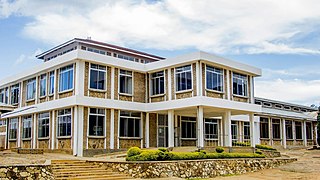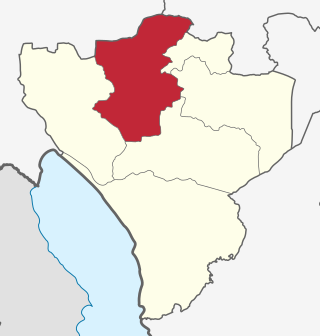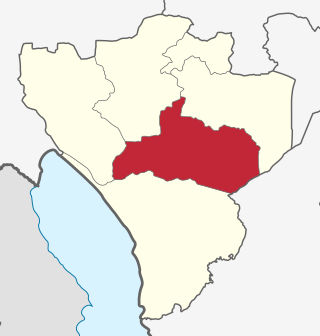
Tanzania is administratively divided into thirty-one regions.

Iringa Region is one of Tanzania's 31 administrative regions. The region covers an area of 35,503 km2 (13,708 sq mi). The region is comparable in size to the combined land area of the nation state of Guinea Bissau. Iringa Region is bordered to the east by Morogoro Region and south by Njombe Region. On the west the region is bodered by Mbeya Region. Dodoma Region and Singida Region border Iringa on the north. The regional capital is the city Iringa for which the city is named after. According to the 2012 census, the region has a total population of 941,238. Iringa Region is home to Ruaha National Park, Tanzania's second national largest park.

Njombe District is a former district of the Iringa Region of Tanzania. The current Njombe districts are Njombe Rural District and Njombe Urban District.

Tanzania faces generalized HIV epidemic which means it affects all sections of the society but also concentrated epidemic among certain population groups. The prevalence of HIV/AIDS in Tanzania is characterised by substantial across age, gender, geographical location and socioeconomic status implying difference in the risk of transmission of infection. In 2019, among 1.7 million people living with HIV/AIDS, the prevalence was 4.6% and 58,000 new HIV infection among 15–49 years old, and 6,500 new infections among children below 15 years old, 50% of all new infections are between 15 - 29 years of age group. Report from Tanzania PHIA of 2016/17 shows that HIV prevalence among women is higher (6.2%) than men (3.1%). The prevalence of HIV is less than 2% among 15-19 years for both males and females and then increases with age for both sexes.
The Bena are Bantu ethnolinguistic group based in the Njombe Region of south-central Tanzania who speak the Bantu Bena language. In 2001, the Bena population was estimated to number 670,000.
The Magoma are a Bantu ethnolinguistic group based in the Makete District of Njombe Region in southern Tanzania. In 2003, the Magoma population was estimated to number 9,000.
Yakobi is a town and ward in Njombe district in the Njombe Region of the Tanzanian Southern Highlands. Its population, according to the 2002 Tanzanian census, is 5,904.
Mtwango is a town and ward in Njombe district in the Njombe Region of the Tanzanian Southern Highlands. Its population according to the 2002 Tanzanian census is 20,487.

Njombe Mjini is an administrative ward in the Njombe Urban District, in the Njombe Region of southern Tanzania.
Wanging'ombe is a town and ward in Wanging'ombe District in the Njombe Region of the Tanzanian Southern Highlands. As of 2002, the population of the ward was 18,545.

Njombe is a town in southern Tanzania. It is the regional capital of Njombe Region as well as the district headquarter of Njombe Rural District and Njombe Urban District. It is located at nearly 2000 meters of altitude on the eastern edge of the Kipengere Range and has the reputation of being a cold town.

Njombe Region is one of Tanzania's 31 administrative regions. The region covers a land area of 21,347 km2 (8,242 sq mi). The region is comparable in size to the combined land area of the nation state of El Salvador. Njombe Region is bordered to the north by the Iringa Region and Mbeya Region, to the east by Morogoro Region, to the south by the Ruvuma Region and to the west by Lake Nyasa. The regional capital is the municipality of Njombe. According to the 2012 national census, the region had a population of 702,097.
Ninga is a town and ward in Njombe Rural District in the Njombe Region of the Tanzanian Southern Highlands. Ninga Ward was created since the 2002 Tanzanian census, so the first population reports for the ward will be for the 2012 census. The name Ninga comes from the Swahili word for dove, ninga.

Wanging'ombe District is one of the six districts of the Njombe Region of Tanzania, East Africa. The administrative seat is in Igwachanya.

Njombe Rural District is one of the six districts of the Njombe Region of Tanzania, East Africa. Its administrative seat is Njombe town.
Kitandililo is a town and ward in Njombe Rural District in the Njombe Region of the Tanzanian Southern Highlands. Kitandililo Ward was created since the 2002 Tanzanian census, so the first population reports for the ward will be for the 2012 census. The town lies on both the north and south banks of the Mlenga River, and there is a station there on the TAZARA Railway which passes through the town.
Ihanga is a town and ward in Njombe Urban District in the Njombe Region of the Tanzanian Southern Highlands.
Lugenge is a town and ward in Njombe Urban District in the Njombe Region of the Tanzanian Southern Highlands.

Njombe Urban District is one of the six districts of the Njombe Region of Tanzania, East Africa. The administrative seat for the district is in the city of Njombe.
Makowo is an administrative ward in Njombe Urban District in the Njombe Region of the Tanzanian Southern Highlands. The ward consists of three villages: Mamongolo, Mkowo and Ng'elamo.
This page is based on this
Wikipedia article Text is available under the
CC BY-SA 4.0 license; additional terms may apply.
Images, videos and audio are available under their respective licenses.









